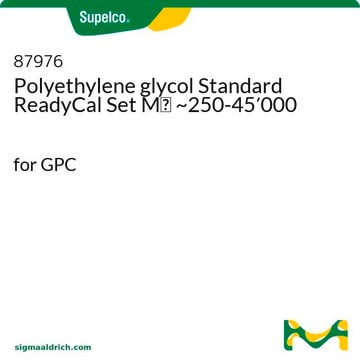96699
Poly(ethylene glycol)
analytical standard, for GPC, 40,000
Synonym(s):
PEG
Sign Into View Organizational & Contract Pricing
All Photos(1)
About This Item
Linear Formula:
H(OCH2CH2)nOH
CAS Number:
MDL number:
UNSPSC Code:
12352104
PubChem Substance ID:
NACRES:
NA.24
Recommended Products
grade
analytical standard
for GPC
Quality Level
shelf life
limited shelf life, expiry date on the label
mol wt
Mn ~36500
Mp ~40000
Mw ~41500
technique(s)
gel permeation chromatography (GPC): suitable
Mw/Mn
~1.14
application(s)
cleaning products
cosmetics
food and beverages
personal care
format
neat
storage temp.
2-8°C
SMILES string
C(CO)O
InChI
1S/C2H6O2/c3-1-2-4/h3-4H,1-2H2
InChI key
LYCAIKOWRPUZTN-UHFFFAOYSA-N
Looking for similar products? Visit Product Comparison Guide
General description
Poly(ethylene glycol) is a nontoxic and non-biodegradable polymer, which can find applications in drug delivery systems.
Application
- Poly(ethylene glycol) in biomaterials synthesis: Research showcases the development of disulfide-cross-linked tetra-PEG gels, highlighting the utility of poly(ethylene glycol) in creating advanced biomaterials that are biocompatible and functional for various biomedical applications (Meng et al., 2024).
- PEGylation reagents for drug delivery: PEG is employed in the formation of hybrid polymersomes for mRNA delivery, demonstrating its critical role in enhancing the stability and cellular uptake of therapeutic agents, thereby improving treatment efficacy and safety (Shin et al., 2024).
- Polyethylene glycol for organic synthesis: PEG is used in solvent-free sample preparations for MALDI-TOF MS of polymer blends, facilitating cleaner and more environmentally friendly processes in polymer analysis and characterization (Dalgic and Weidner, 2024).
- PEG reagents for protein modification: PEG-based block copolymers are synthesized for drug delivery applications, where PEGylation significantly increases the solubility and stability of therapeutic molecules, enhancing their pharmacological profiles (Parcero-Bouzas et al., 2024).
- Poly(ethylene glycol) in biotechnology: PEG is integrated into bioplastic formulations to improve the crystallization, thermal, and mechanical properties of poly(L-lactide) bioplastics, underscoring its versatility and importance in developing sustainable materials (Pakkethati et al., 2024).
Storage Class Code
11 - Combustible Solids
WGK
WGK 1
Flash Point(F)
281.5 °F - closed cup
Flash Point(C)
138.6 °C - closed cup
Personal Protective Equipment
dust mask type N95 (US), Eyeshields, Gloves
Choose from one of the most recent versions:
Already Own This Product?
Find documentation for the products that you have recently purchased in the Document Library.
Customers Also Viewed
Pharmacokinetic and biodistribution properties of poly (ethylene glycol)-protein conjugates.
Caliceti P and Veronese MF
Advanced Drug Delivery Reviews, 55(10), 1261-1277 (2003)
Poly (ethylene glycol) in drug delivery: pros and cons as well as potential alternatives.
Knop K, et al.
Angewandte Chemie (International Edition in English), 49(36), 6288-6308 (2010)
Idalis Villanueva et al.
Acta biomaterialia, 5(8), 2832-2846 (2009-06-11)
The pericellular matrix (PCM) surrounding chondrocytes is thought to play an important role in transmitting biochemical and biomechanical signals to the cells, which regulates many cellular functions including tissue homeostasis. To better understand chondrocytes interactions with their PCM, three-dimensional poly(ethylene
I L Konorova et al.
Patologicheskaia fiziologiia i eksperimental'naia terapiia, (4)(4), 7-9 (1991-07-01)
The search for antiaggregatory compounds is undertaken, as a rule, under in vitro conditions which do not reflect the dynamics of the real process. The present work deals with study of the peculiarities of the development of the collagen induced
P I Polimeni et al.
Journal of cardiovascular pharmacology, 14(3), 374-380 (1989-09-01)
The acute hemodynamic effects of an intravenously (i.v.) injected poly(ethylene oxide), Polyox WSR N-60K (dose 50 mg/kg), were studied in the open-chest rat anesthetized with sodium pentobarbital. The injectate is one of four drag-reducing polymers known to augment in vitro
Our team of scientists has experience in all areas of research including Life Science, Material Science, Chemical Synthesis, Chromatography, Analytical and many others.
Contact Technical Service

